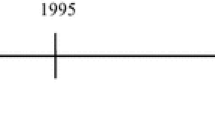Abstract
Criteria of approximate scientific success are defined within a formal paradigm of empirical inquiry. One consequence of aiming for less than perfect truth is examined.
Similar content being viewed by others
References
L. Blum and M. Blum. Toward a mathematical theory of inductive inference.Information and Control,28:125–155, 1975.
C. C. Chang and H. J. Keisler.Model Theory (2nd Edition). North-Holland, Amsterdam, 1977.
J. Case and C. Smith. Comparison of identification criteria for machine inductive inference.Theoretical Computer Science,25:193–220, 1983.
John Earman and Clark Glymour. Relativity and eclipses: The British eclipse expeditions of 1919 and their predecessors.Historical Studies in the Physical Sciences,11:49–85, 1980.
H. Enderton.A Mathematical Introduction to Logic. Academic Press, New York, 1972.
Paul K. Feyerabend.Against Method NLB, London, 1975.
M. Fulk and S. Jain. Approximate inference and scientific method.Information and Computation, in press.
Clark Glymour and Kevin Kelly. On convergence to the truth and nothing but the truth.Philosophy of Science,56, 1989.
E. M. Gold. Limiting recursion.Journal of Symbolic Logic,30(1):27–48, 1965.
H. Gaifman, D. Osherson, and S. Weinstein. A reason for theoretical terms.Erkenntnis,32:149–159, 1990.
Kevin Kelly and Clark Glymour. Inductive inference from theory laden data.Journal of Philosophical Logic, 21:391–444, 1992.
Kevin Kelly and Clark Glymour. Theory discovery from data with mixed quantifiers.Journal of Philosophical Logic,19:1–33, 1990.
Kevin Kelly and Cory Juhl. A characterization of almost stable identification over arbitrary inductive settings.Manuscript, 1992.
Thomas S. Kuhn.The Copernican Revolution: planetary astronomy in the development of Western thought. Random House, New York, 1959.
Thomas S. Kuhn.The Structure of Scientific Revolutions. University of Chicago Press, Chicago, 1962.
I. Lakatos. Falsification and the methodology of scientific research programmes. In J. Worral and G. Currie, editors,The Methodology of Scientific Research Programmes, pages 8–101. Cambridge University Press, Cambridge MA, 1978.
D. Osherson, M. Stob, and S. Weinstein. Mechanical learners pay a price for bayesianism.Journal of Symbolic Logic,53(4):1245–1251, 1988.
D. Osherson, M. Stob, and S. Weinstein. A mechanical method of successful scientific inquiry. In M. Fulk and J. Case, editors,Proceedings of the Third Annual Workshop on Computational Learning Theory, pages 187–291. Morgan Kaufmann Publishers, Inc., 1990.
D. Osherson, M. Stob, and S. Weinstein. A universal inductive inference machine.Journal of Symbolic Logic,56(2):661–672, 1991.
D. Osherson, M. Stob, and S. Weinstein. A universal method of scientific inquiry.Machine Learning,9:261–271, 1992.
D. Osherson, M. Stob, and S. Weinstein. Logic and learning. In S. Hanson, G. Drastal, and R. Rivest, editors,Computational Learning Theory and Natural Learning Systems. M.I.T. Press, Cambridge MA, In press.
D. Osherson and S. Weinstein. Criteria of language learning.Information and Control,52:123–138, 1982.
D. Osherson and S. Weinstein. Identification in the limit of first-order structures.Journal of Philosophical Logic,15:55–81, 1986.
D. Osherson and S. Weinstein. Identifiable collections of countable structures.Philosophy of Science,18:1–42, 1989.
D. Osherson and S. Weinstein. Paradigms of truth-detection.Journal of Philosophical Logic,18:1–42, 1989.
D. Osherson and S. Weinstein. Relevant consequence and empirical.Journal of Philosophical Logic,22:437–448, 1993.
C. S. Peirce.Collected Papers of C. S. Peirce. (A. W. Burks, Editor) Harvard University Press, Cambridge MA, 1958.
K. Popper.The Logic of Scientific Discovery. Hutchinson, London, 1959.
Hilary Putnam. Trial and error predicates and a solution to a problem of mostowski.Journal of Symbolic Logic,30(1):49–57, 1965.
H. Putnam. Probability and confirmation. InMathematics, Matter, and Method. Cambridge University Press, 1975.
H. Rogers.Theory of Recursive Function and Effective Computability. McGraw-Hill, New York, 1967.
J. Royer. Inductive inference of approximations.Information and Control,70:156–178, 1986.
G. Schurz and P. Weingartner. Verisimilitude defined by relevant consequenceelements. A new reconstruction of Popper's idea. In T. A. Kuipers, editor, What is Closer-to-the-Truth? Rodopi, Amsterdam, 1987.
John Watkins.Science and Scepticism. Princeton University Press, Princeton, NJ, 1984.
Author information
Authors and Affiliations
Rights and permissions
About this article
Cite this article
Osherson, D., Weinstein, S. On the danger of half-truths. J Philos Logic 24, 85–115 (1995). https://doi.org/10.1007/BF01052732
Issue Date:
DOI: https://doi.org/10.1007/BF01052732



